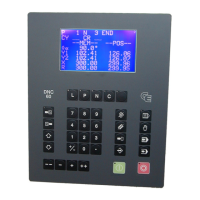ANNEX G: SUNDRIES PAGE 69
Procedure to realize an ideal curve
In this example, an ideal curve having an internal radius of 50 mm is to be
made.
Call the PRODUCT STATUS page and fill in the fields as described
below.
P 0 P+ ___ N 1 I/mm
CODE CAL_/__.__
p/d 1/ 1 St:1 Al:_ SS:_
Th: 2.00 Kg/mm² 45.000
Lmat 2000 Dev L ___.__
-N- -L- - - -p/d- -ri- CR TOL
1 100.00 90.0°__/__ 50 00 15 ___
2 200.00 90.0°__/__ ____.__ __ ___
3 100.00 ____._°__/__ ____.__ __ ___
4 ____.__ ____._°__/__ ____.__ __ ___
5 ____.__ ____._°__/__ ____.__ __ ___
____.__ ____._°__/__ ____.__ __ ___
Press the key.
The system fills in the Dev L, ri and TOL fields.
Lmat 2000 Dev L 372.79
-N- -L- - - -p/d- -ri- CR TOL
1 100.00 90.0° 1/ 1 50 00 15 0
2 200.00 90.0° 1/ 1 2.13 __ ___
3 100.00 ____._°__/__ ____.__ __ ___
The number 15 gives a good approximation, as the tolerance, that is the dif-
ference between the apex of the chord and the theoretical radius, is 0 mm.
The calculated values vary in function of the thickness, the V opening of the
die, etc.
Press the
key and fill in the LEG and FACE fields as below.
P 0 N 1 p/d 1/ 1
N FACE LEG CR p/d
1 1 0 15 1/ 1
2 2 1 __ 1/ 1
Attention The X MEM values on the sequence page do not correspond to the position
actually aimed for by the axis during ideal curve.

